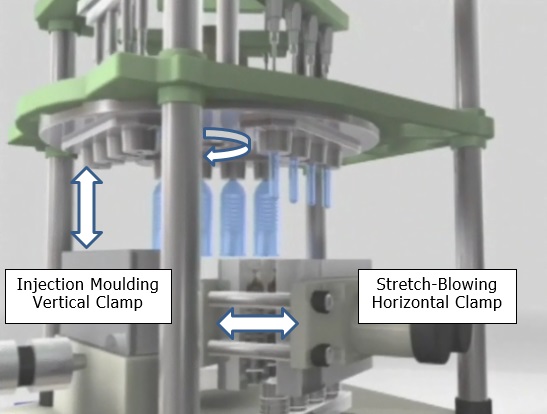Conventional PET Processing
PET bottles and jars exhibit superior transparency, gloss and strength and as a result have been replacing many other materials for the packaging of beverages, foodstuffs, pharmaceuticals, cleaning products, personal care products and chemicals.
PET containers are produced in two steps, firstly by injection molding of test-tube shaped PET preforms from PET granules raw material and secondly by stretch blow molding these preforms into bottles or jars.

There are two distinct processes (types of machines) that are commonly used to produce PET bottles and jars.
Two-stage process: The bottles are produced on machines that implement step 2 by taking ready preforms, heating them and stretch blow molding them into bottles. Two-stage machines are normally used for high production outputs of beverage bottles, using PET preforms with standard neck sizes, which are readily available in the market. About 80% of the PET containers produced globally are made on two-stage, re-heat stretch-blowing machines.
Conventional Single-stage process: The bottles are produced on machines that implement BOTH steps 1 and 2 by using PET raw material to mold preforms and then directly stretch-blow-molding these preforms into the finished bottles or jars. Single-stage machines are well suited to medium production rates as well as for containers with non-standard necks, for which preforms would not be readily available in the market. About 20% of the PET bottles and jars produced globally are made with single-stage machines. Such machines typically have three or four stations (injection, {conditioning,} stretch-blowing and container ejection) with a rotary indexing table for transferring the preforms between stations. There are separate clamping units for opening and closing the injection molds (vertical clamp) and the blow molds (horizontal clamp).

Single stage vs Two stage Injection Stretch Blow Molding Comparison:
Conventional Single stage process has the following advantages over Two Stage Process:
- Lower electricity consumption. The molded preforms do not have to be completely cooled after injection molding and then re-heated for stretch blowing.
- Lower resources requirements. No need for packing, storing and transporting preforms.
- Suitable for all containers irrespective of neck design and weight. There is no restriction to only the preforms available on the market.
- Superior container clarity and gloss, as there is no preform surface deterioration due to storage and transport.
- Flexibility to produce a very wide variety of container sizes, shapes and neck diameters on the same machine.
Two Stage process has the following advantages over Single Stage:
- Much higher production outputs are possible.
Sunstainability
PET is the only commonly used plastic that can be polymerized in the solid state, which allows PET to be polymerized (upgraded) during recycling. Recycled PET can therefore be upgraded to the original virgin PET mechanical properties. Recycled PET can also be suitable for Food Contact Applications. The result is that PET can be recycled repeatedly, for a fully circular economy. Many multinational brands use 100% recycled PET in their bottles. Many others are replacing their HDPE packaging with PET packaging made from 100% recycled PET.
CYPET has performed a Life Cycle Analysis on 20L stackable packaging used for bulk transport of oils and chemicals, calculating that the carbon footprint of PET packaging solutions is around 50% compared to the existing HDPE 20L packaging. One main reason for this is the lower weight of the PET packaging, followed by the low energy required by the CYPET machine to transform the raw material into a finished container. CYPET is working with industry leaders to develop next generation packaging made from PET material, to help accelerate the transition to the most sustainable packaging possible.

